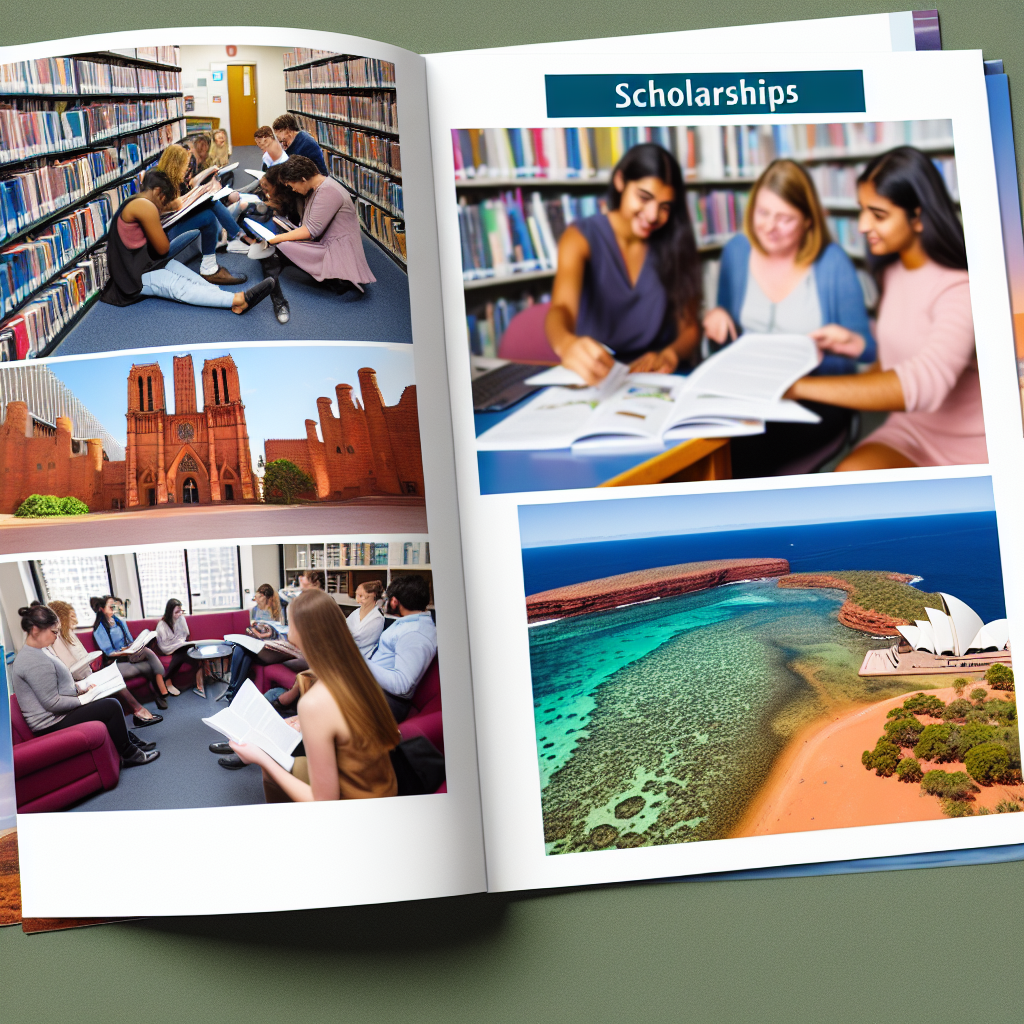
Finding and applying for scholarships in Australia: A practical guide
-
Table of Contents
“Unlock Your Potential: A Practical Guide to Finding and Applying for Scholarships in Australia”
Introduction
Navigating the landscape of scholarships in Australia can be a daunting task for both domestic and international students. Scholarships provide essential financial support, making higher education more accessible and alleviating some of the financial burdens associated with university life. This practical guide aims to streamline the process of finding and applying for scholarships in Australia. It covers various types of scholarships available, including those based on academic merit, sports achievements, community involvement, and financial need, as well as tips on how to enhance your application and increase your chances of success. Whether you are just starting your academic journey or looking to further your education, understanding how to effectively search for and secure scholarships can significantly impact your educational experience and future career opportunities.
Understanding Scholarship Types and Eligibility Criteria in Australia
Finding and applying for scholarships in Australia can be a transformative step for students aiming to manage the financial aspects of their education. It is crucial, however, to begin by understanding the various types of scholarships available and the specific eligibility criteria associated with them. This knowledge not only streamlines the application process but also enhances the chances of securing financial support.
In Australia, scholarships are broadly categorized into several types based on their purpose, funding source, and eligibility requirements. Academic scholarships are perhaps the most well-known, awarded primarily on the basis of academic excellence and achievement. These scholarships are highly competitive and often require applicants to maintain a certain grade point average along with a strong overall academic record.
Equally significant are equity scholarships, designed to assist students from disadvantaged backgrounds. These might include individuals from low socio-economic backgrounds, indigenous students, or those who have faced significant personal challenges. The criteria for these scholarships extend beyond academic performance, focusing more on personal circumstances and potential for future success.
Another category includes sports scholarships, which are offered to students who excel in a particular sport. These scholarships not only help cover education costs but also provide support for sporting pursuits, which can include access to advanced training facilities and coaching. Similarly, there are scholarships specifically aimed at students excelling in the arts, such as music, drama, or visual arts, recognizing their talents and providing avenues to further cultivate these skills alongside their academic education.
Transitioning from types to eligibility, it is essential for applicants to meticulously review the criteria set by each scholarship. Eligibility can be influenced by a variety of factors including, but not limited to, academic achievements, financial need, community involvement, leadership qualities, field of study, and residency status. Some scholarships are specifically designed for international students, offering them an opportunity to pursue education in Australia, which can be particularly helpful given the higher tuition fees and living expenses they might face.
Moreover, each scholarship may have its unique application requirements. These could range from submitting personal statements, recommendation letters, proof of community service, or portfolios of work, depending on the scholarship’s focus. Understanding these requirements is crucial as it allows the applicant to prepare a comprehensive and tailored application that highlights their strengths and alignment with the scholarship’s objectives.
Furthermore, deadlines for scholarship applications can vary significantly. Some scholarships are open for application year-round, while others have strict deadlines. It is advisable for students to create a calendar of relevant scholarship deadlines and plan their application process accordingly, ensuring they have ample time to gather all necessary documents and prepare their submissions without haste.
In conclusion, navigating the landscape of scholarships in Australia requires a thorough understanding of the different types available and the specific eligibility criteria associated with each. By carefully assessing their own backgrounds and achievements, students can identify the scholarships for which they are best suited. This strategic approach not only saves time but also increases the likelihood of securing financial support, thereby making higher education more accessible and less burdensome.
Step-by-Step Guide to Applying for Scholarships in Australia
Finding and applying for scholarships in Australia can seem daunting, but with a structured approach, you can navigate this process effectively. This practical guide will walk you through the essential steps to identify and apply for scholarships that can help alleviate the financial burden of your studies.
The first step in your scholarship journey is to conduct thorough research. Australian educational institutions and various external bodies offer a plethora of scholarships for domestic and international students. Begin by visiting the websites of universities you are interested in, as they typically have a scholarships page detailing available awards, eligibility criteria, and application deadlines. Additionally, utilize government and educational websites such as the Australian Government’s Department of Education, Skills and Employment, which provides resources and links to scholarships for all levels of tertiary education.
Once you have compiled a list of potential scholarships, the next step is to understand the eligibility requirements. These can vary significantly from one scholarship to another. Criteria may include academic achievements, financial need, community involvement, field of study, and specific attributes such as leadership skills or a commitment to particular values. It is crucial to carefully read these requirements to ensure you only spend time applying for scholarships for which you are eligible.
After identifying the scholarships you qualify for, the next phase is preparing your application. This often involves gathering documents such as transcripts, proof of enrollment, and identification. Additionally, you may need to prepare written materials like a personal statement or essay. These writings are your opportunity to explain your academic and career goals, demonstrate how the scholarship will help achieve these goals, and showcase your achievements and potential. Pay close attention to the prompts provided and tailor your responses to align with the goals and values of the scholarship provider.
Letters of recommendation are another common requirement. These should ideally be written by academic advisors, professors, or professional mentors who are familiar with your academic performance and personal character. It’s advisable to approach potential referees early to give them ample time to prepare a thoughtful recommendation.
Furthermore, some scholarships may require proof of community service or extracurricular involvement. Keeping a record of your participation in these activities throughout your academic career can be beneficial when it comes time to provide evidence of your engagement.
Once you have all the necessary documents and have completed your written submissions, review your application carefully. Ensure that all information is accurate and that you have addressed all aspects of the application requirements. It can be helpful to have someone else review your application as well; fresh eyes might catch errors you have overlooked and can offer valuable feedback on how your application could be improved.
Finally, be mindful of the application deadlines. Submitting your application early can be advantageous as it not only demonstrates your enthusiasm and organizational skills but also ensures that any technical difficulties or last-minute emergencies do not prevent you from applying.
In conclusion, while the process of finding and applying for scholarships in Australia requires effort and attention to detail, the potential financial and academic benefits are significant. By methodically researching opportunities, carefully preparing your application, and adhering to deadlines, you can increase your chances of securing a scholarship that supports your educational pursuits.
Tips for Crafting Winning Scholarship Essays and Applications
Finding and applying for scholarships in Australia can be a transformative step towards achieving your educational goals. A crucial component of this process is mastering the art of crafting compelling scholarship essays and applications. This practical guide will provide you with essential tips to enhance your chances of success.
Firstly, understanding the purpose of the scholarship essay is key. Scholarship committees are not just looking for academically excellent candidates, but individuals who can present their experiences, aspirations, and qualifications in a coherent and persuasive manner. Therefore, before you begin writing, take the time to reflect on your personal journey, the challenges you have overcome, and what makes you a unique candidate for the scholarship.
Once you have a clear understanding of your key messages, start by carefully reading the essay prompt. It is crucial to address every part of the question thoroughly. Missing out on a segment of the prompt can be a common pitfall. To avoid this, break down the prompt into manageable parts and ensure that your essay addresses each component. This approach not only shows your attention to detail but also your commitment to complying with the requirements.
Transitioning from planning to drafting, remember to adopt a structured approach to your writing. An effective scholarship essay typically has a clear introduction, a detailed body, and a concise conclusion. The introduction should hook the reader and clearly state the purpose of your essay. Use the body to elaborate on your points, providing specific examples and experiences that align with the scholarship’s criteria. Each paragraph should connect smoothly to the next, maintaining a logical flow of ideas. Concluding your essay, reiterate how the scholarship will help you achieve your educational and career objectives, and thank the committee for considering your application.
Language and tone play pivotal roles in the effectiveness of your scholarship application. Opt for clear, concise, and formal language that reflects your educational level and professionalism. Avoid slang and overly casual phrases that might undermine the seriousness of your application. Additionally, maintain a positive and confident tone throughout the essay. Even when discussing challenges or failures, focus on what you have learned from those experiences and how they have prepared you for future successes.
Proofreading is another critical step in the application process. Typos, grammatical errors, and awkward phrasing can distract from the content of your essay and give a poor impression to the scholarship committee. After you have completed your draft, take a break and return with fresh eyes to edit your work. It is also advisable to have someone else review your essay. Feedback from teachers, mentors, or peers can provide new insights and help you refine your application further.
Finally, beyond the essay, ensure that every part of your application is completed to the highest standard. Fill out forms meticulously, and keep all supporting documents organized and professional. Meeting deadlines is equally important; late applications are typically not considered.
In conclusion, while the process of applying for scholarships in Australia can be daunting, focusing on crafting a thoughtful, well-structured, and polished essay can significantly increase your chances of success. By following these tips, you will be able to present a compelling narrative to scholarship committees, showcasing your worthiness as a candidate.
Key Deadlines and Resources for Australian Scholarship Applicants
Finding and applying for scholarships in Australia requires careful planning and awareness of key deadlines, as well as utilizing a variety of resources to increase your chances of success. This practical guide aims to provide you with essential information to navigate through the process effectively.
One of the first steps in your scholarship journey is to understand the critical timelines associated with different scholarships. Australian educational institutions and scholarship providers typically set specific deadlines that are rigid and vary significantly from one scholarship to another. For instance, scholarships for academic programs commencing in February may have application deadlines as early as the previous October. Consequently, it is crucial to start your research early and create a calendar of deadlines to ensure you do not miss out on any opportunities.
Moreover, the timing of your application can significantly impact your eligibility and success. Many scholarships are awarded on a first-come, first-served basis, while others are highly competitive, with thousands of applicants vying for a limited number of spots. By preparing your application materials well in advance and submitting them as early as possible, you can avoid the last-minute rush and increase your chances of making a strong impression on the selection committee.
Transitioning from the importance of deadlines, it is equally vital to utilize the right resources to find scholarships that match your specific needs and qualifications. Numerous online platforms and tools can assist you in this endeavor. The Australian Government’s official website for international students, for example, provides a comprehensive database of scholarships available to students from various countries and fields of study. This resource is invaluable for identifying both government-funded and private scholarships.
Additionally, individual universities often have dedicated sections on their websites where they list available scholarships, detailing the application process, eligibility criteria, and benefits. Visiting these pages regularly can provide you with up-to-date information directly from the institutions. For more personalized assistance, the scholarship office or financial aid office at your chosen university can be a crucial resource. They can offer guidance specific to your situation and help you navigate the often complex landscape of scholarship applications.
Another excellent resource is the network of past and current scholarship recipients. Engaging with these individuals through online forums, social media groups, or university alumni networks can provide insider tips and firsthand accounts of the application process and what evaluators are looking for. This interaction not only prepares you better but also helps in building a support system that can be beneficial throughout your educational journey.
Lastly, do not overlook the value of local organizations and community groups that might offer scholarships or grants. These are often less competitive but equally valuable in terms of financial support and professional networking opportunities. Regularly checking community boards, speaking with school counselors, and joining relevant groups can uncover these lesser-known opportunities.
In conclusion, successfully applying for scholarships in Australia demands a proactive approach—starting with a clear understanding of key deadlines and making the most of diverse resources. By meticulously planning your application timeline and actively seeking out various informational avenues, you can enhance your prospects of securing a scholarship that supports your academic and career ambitions. Remember, the effort you put into the application process can make a significant difference in the outcome.



